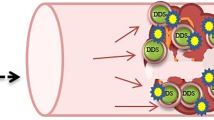Summary
Part I of the present paper described the development of a substance for endovascular embolization from homologous fibrinogen, aprotinin, thrombin, metrizamide and CaCl2. Part II deals with the applicability of a controlled-viscosity fibrin mixture via different types of arterial catheters. In a flow-dynamic model the embolizing medium injected via a double syringe was shown to block a blood flow corresponding approximately to the flow encountered in cerebral angioma vessels.
In the course of animal experiments the embolization of mesenteric arteries of rabbits showed the distribution of the embolizing medium to be dependent on its viscosity; the action of an embolizing medium applied by means of a double syringe was studied in the femoral arteries of rabbits. Scintigraphy was used to study the distribution of the substance in the body of the experimental animal after intravenous (i.v.) application; long-term studies of embolized auricular arteries in rabbits revealed parchment-like necroses after 5 to 10 days and the presence of radiopaque substances in the ear stumps after 6 weeks.
Similar content being viewed by others
References
Berenstein, A., Kricheff, I. I., Catheter and material selection for transarterial embolization, technical considerations. Part I and II. Neuroradiology132 (1979), 619–639.
Berenstein, A., Technique of catheterization and embolization of the lenticulostriate arteries. J. Neurosurg.54 (1981), 783–789.
Czirják, S., Pásztor, E., Lázár, L., Deák, G., Lányi, F., Significance of balloon catheter selective and superselective angiography in the diagnosis of cerebral vascular malformations. Acta neurochir. (Wien)58 (1981), 85–89.
Cromwell, L. D., Harris, A. B., Treatment of cerebral artenovenous malformations, a combined neurosurgical and neuroradiological approach. J. Neurosurg.52 (1980), 705–708.
Djindjian, R., Cophignon, J., Théron, J., Merland, J. J., Houdart, R., Embolization by superselective arteriography from the femoral route in neuroradiology; review of 60 cases. Neuroradiology6 (1973), 20–26.
Djindjian, R., Superselective internal carotid arteriography and embolization. Neuroradiology9 (1975), 145–156.
Dotter, C. T., Goldman, M. L., Rösch, J., Instant selective arterial occlusion with isobuthyl-cyanoacrylate. Radiology114 (1975), 227–230.
Günther, R., Klose, K., Thelen, M., Jacobi, G., Superselektive Embolisation mit Gewebekleber im Urogenitaltrakt. Fortschr. Röntgenstr.134 (1981), 536–539.
Hilal, S. K., Michelsen, J. W., Therapeutic percutaneous embolization for extra-axial vascular lesions of the head, neck, and spine. J. Neurosurg.43 (1975), 275–287.
Ingenor, F-75020 Paris, personal communication.
Kerber, C., Balloon catheter with a calibrated leak. Radiology120 (1976), 547–550.
Laine, R., Jomin, M., Clarisse, J., Combelles, G., Les malformations artérioveneuses cérébrales profondes. Neurochirurgie27 (1981), 147–160.
Lehman, R. A. W., Hayes, G. J., The toxicity of alkyl 2-cyanoacrylate tissue adhesives: Brain and blood vessels. Surgery61 (1967), 915–922.
Luessenhop, A. J., Kachmann, R., Shevlin, W., Ferrero, A. A., Clinical evaluation of artificial embolization in the management of large cerebral arteriovenous malformations. J. Neurosurg.23 (1965), 400–417.
Luessenhop, A. J., Mujica, P. H., Embolization of segments of the circle of Willis and adjacent branches for management of certain inoperable cerebral arteriovenous malformations. J. Neurosurg.54 (1981), 573–582.
Matras, H., Jesch, W., Kletter, G., Dinges, H. P., Spinale Duraklebung mit Fibrinkleber. Wien. klin. Wschr.90 (1978), 419–425.
Merland, J. J., Riche, M. C., Chiras, J., Bories, J., Therapeutic angiography in neuroradiology. Classical data, recent advances and perspectives. Neuroradiology21 (1981), 111–121.
Nornes, H., Grip, A., Hemodynamic aspects of cerebral arteriovenous malformations. J. Neurosurg.53 (1980), 456–464.
Parkinson, D., Bachers, G., Arteriovenous malformations. J. Neurosurg.53 (1980), 285–299.
Picard, L., André, J. M., Roland, J., Montaut, J., Lepoire, J., Arnould, G., Kissel, P., L'embolization; intérêt et indications en oto-neuro-ophtalmologie. Oto-Neuro-Opht.47 (1975), 79–89.
Picard, L., André, J. M., Roland, J., Sigiel, M., Montaut, J., Lepoire, J., L'embolisation dans les malformations vasculaires méningo-cranio-cutanées complexes. J. Neuroradiologie2 (1975), 233–256.
Picard, L., Even, J., Bertrand, A., Floquet, J., Yvroud, E., Folcher, J., Sigiel, M., Marchal, A. L., l'Espérance, G., Roland, J., Embols plastiques fluides. J. Neuroradiology4 (1977), 385–398.
Rassweiler, J., Kauffmann, G. W., Rohrbach, R., Richter, G., Kapilläre Embolisation, Teil I: Verschluß des gesamten arteriellen Gefäßsystems der gesunden Rattenniere. Fortschr. Röntgenstr.133 (1980), 644–653.
Redl, H., Schlag, G., Dinges, H., Kuderna, H., Seelich, T., Background and methods of “Fibrin Sealing”. Proc. of the 1st World Biomaterial Congress (Winter, G. D., ed.). Chichester: Wiley Lim. 1981.
Richling, B., Ascherl, R., Blümel, G., Endovascular embolization with homologous fibrin; long-term studies. In preparation.
Richter, G., Rohrbach, R., Kauffmann, G. W., Raßweiler, J., Kapilläre Embolisation, Teil II: Verschluß des gesamten arteriellen Gefäßsystems experimentell erzeugter Nierentumoren. Fortschr. Röntgenstr.135 (1981), 85–97.
Sano, K., Jimbo, M., Saito, I., Basugi, N., Artificial embolization of inoperable angioma with polymerizing substance. In: Cerebral angiomas (Pia, H. W.,et al., eds.), pp. 222–229. Berlin-Heidelberg-New York: Springer. 1975.
Seelich, T., Redl, H., Fibrinkleber, 1. Theoretischer und experimenteller Teil. In: Fibrinogen, Fibrin und Fibrinkleber (Schimpf, K., ed.), pp. 199–208. Stuttgart-New York: Schattauer. 1980.
Vinters, H. V., Debrun, G., Kaufmann, J. C., Drake, C. G., Pathology of arteriovenous malformations embolized with isobutyl-2-cyanoacrylate (bucrylate); report of two cases. J. Neurosurg.55 (1981), 819–825.
Vlahovitch, B., Fuentes, J. M., Embolization of cerebral angiomas by catheterization of cortical arteries. Neuroradiology11 (1976), 243–248.
White, R. I., Strandberg, J. V., Gross, C. S.,et al., Therapeutic embolization with long-term occluding agents and their effects on embolized tissues. Radiology125 (1977), 677–687.
Wolf, K. J., Therapeutische Embolisation von Organarterien — Tierexperimentelle Untersuchungen, erste klinische Erfahrungen, Einführung eines neuen Embolisationsmaterials, Teil 1. Fortschr. Röntgenstr.128 (1978), 414–422.
Wolf, K. J., Therapeutische Embolisation von Organarterien — Tierexperimentelle Untersuchungen, erste klinische Erfahrungen, Einführung eines neuen Embolisationsmaterials, Teil 2. Fortschr. Röntgenstr.131 (1979), 511–519.
Zanetti, P. H., Sherman, F. E., Experimental evaluation of a tissue adhesive as an agent for the treatment of aneurysms and arteriovenous anomalies. J. Neurosurg.36 (1972), 72–79.
Author information
Authors and Affiliations
Rights and permissions
About this article
Cite this article
Richling, B. Homologous controlled-viscosity fibrin for endovascular embolization. Acta neurochir 64, 109–124 (1982). https://doi.org/10.1007/BF01405624
Issue Date:
DOI: https://doi.org/10.1007/BF01405624




